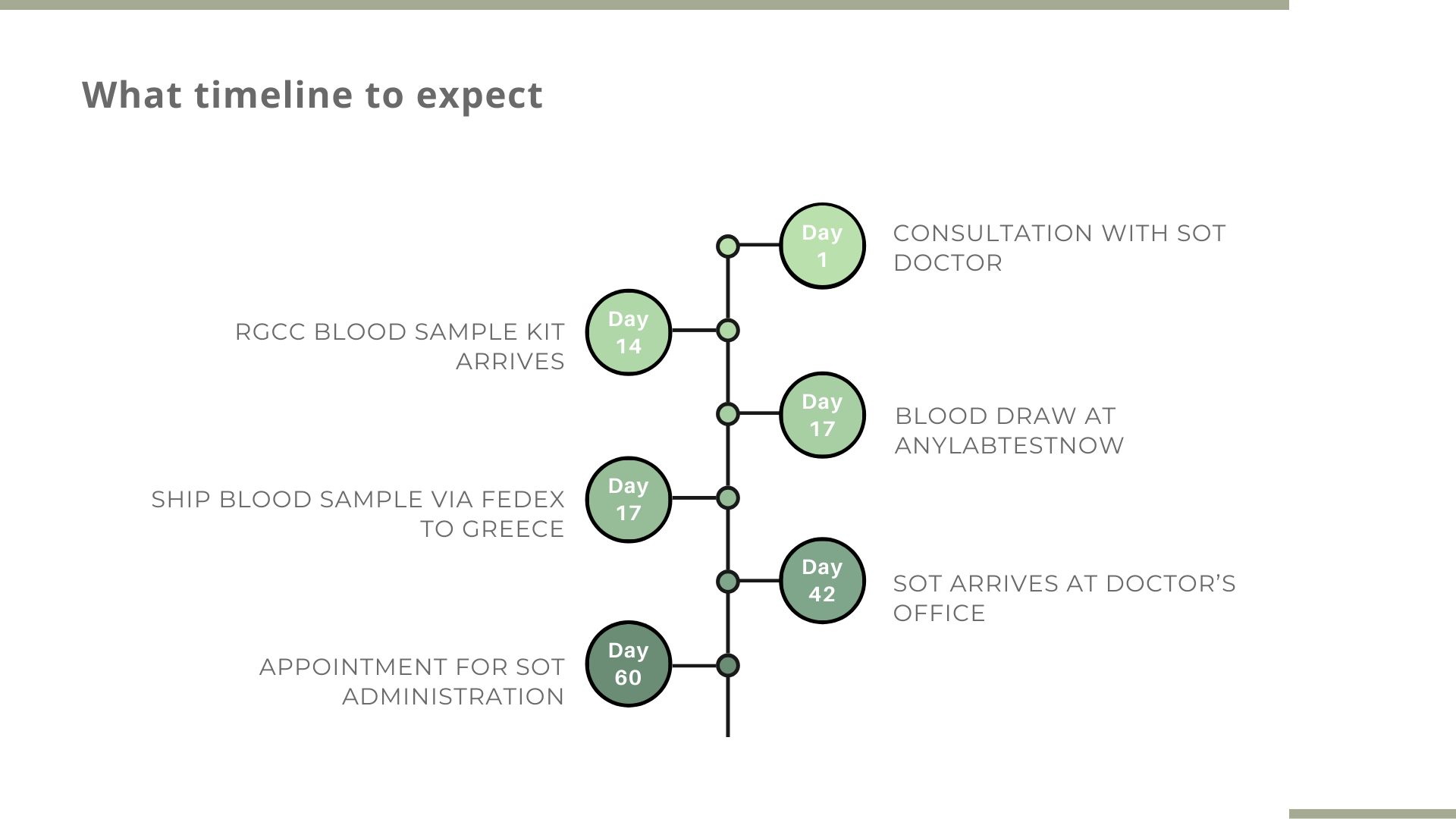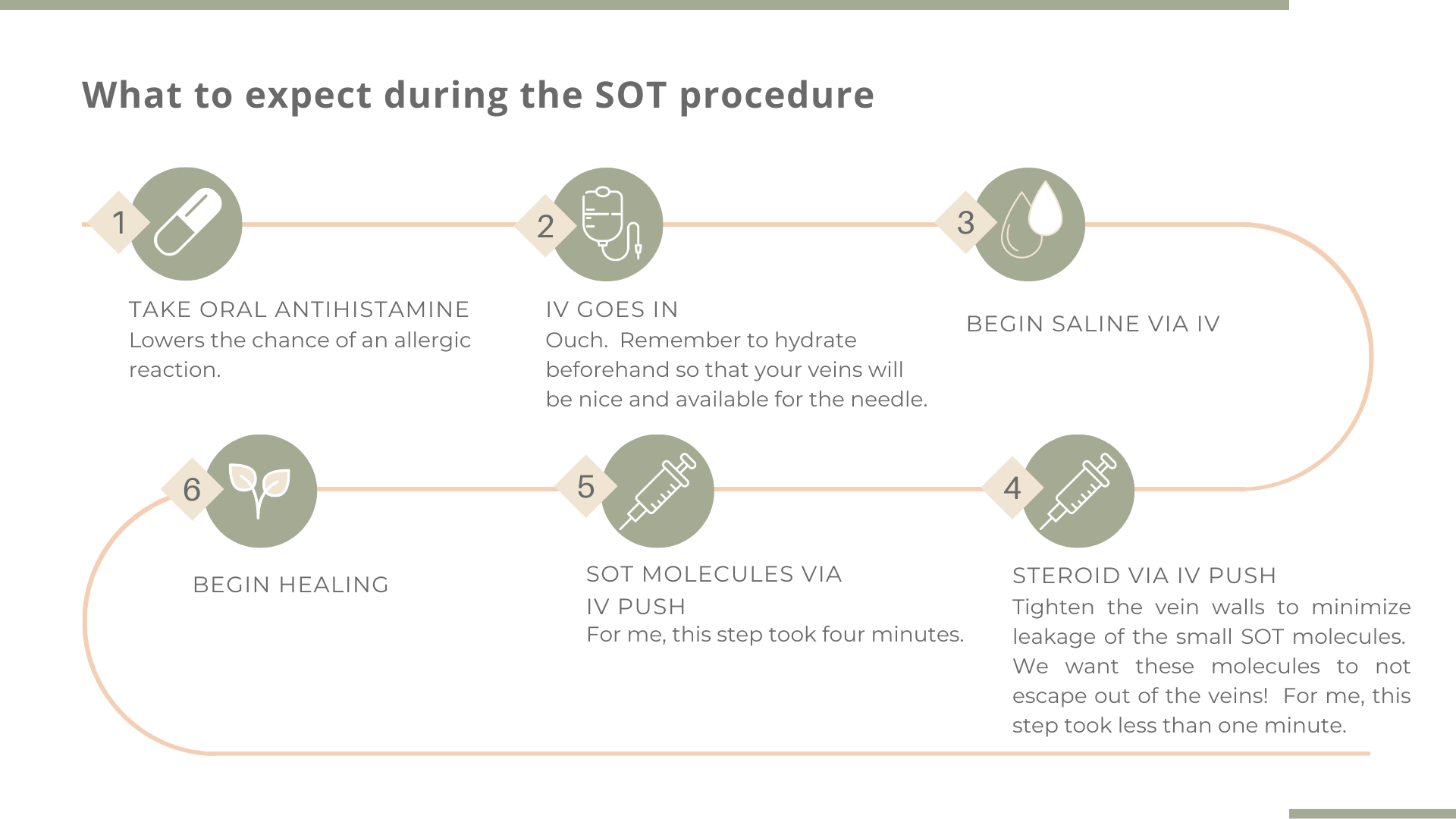Have you heard of Supportive Oligonucleotide Technique, or SOT, for Lyme treatment? I first heard about the treatment within a couple weeks of my official diagnosis, and was immediately intrigued.
What is SOT?
SOT is a treatment for cancer and many viruses, like Epstein-Barr, Lyme, and its co-infections. You may also see it referred to as Antisense Oligonucleotide Technique. While the technique has been more widely used in Europe, it is still fairly new in the US. SOT involves molecules specific to an individual’s DNA, and these molecules prevent a pathogen from further replicating. The RGCC lab (http://www.rgcc-group.com/) in Greece is the only lab that prepares the SOT molecules.
How does it work?
Like the cells in our bodies, Lyme bacteria (spirochetes) replicates, having a life cycle of around 80 days. Each pathogen has a specific section of DNA that is fundamental to the cell’s function. SOT involves the creation of small molecules customized to an individual’s species of Lyme bacteria, acting as a key that disrupts this specific, important portion of the DNA. Note that species is different from strain — species means the bacteria itself, such as Borrelia burgdorferi, Borrelia mayonii, Borrelia afzelii. Each species can be one of various strains. For example, the Borrelia burgdorferi sensu stricto species in the US may include the Borrelia burgdorferi B31 or Borrelia burgdorferi 297 strains.
Typically, protective Lyme biofilm needs to be broken down in order to attack the spirochetes, but the SOT molecules are small enough to penetrate the biofilm. This ultimately shuts off the ability of the Lyme cell to replicate. The SOT molecules then remain active in the bloodstream, attacking other Lyme cells 24/7, for 24-28 weeks — that’s six months! Once the replication sequences of the Lyme cells have been shut down, the next generation of pathogens are eliminated. This, combined with the die-off due to the life-cycle of the existing Lyme bacteria, means eventually there is no pathogen left!
When should one consider SOT?
This was one of my first questions when I initially heard of SOT. It was early in my Lyme treatment, so should I be trying antibiotics (the “traditional” route) first? Is it only after I’ve tried treatment x and y that I try SOT? Ultimately, based on many Lyme sufferer’s personal accounts, while there is no specific sequence of treatment steps to follow before considering SOT, one message was clear: the earlier the better. There is little downside to trying this treatment.
For me, I’m used to running experiments on webpages, isolating one variable to change in order to measure the impact of this change. Shouldn’t I view SOT similarly, treating with just this method and seeing if it has been effective? Not at all. My perspective had to evolve. This isn’t a controlled experiment — all possible variables are not taken into account. What’s important is that my entire holistic treatment plan is effective for my healing. Attacking Lyme with a multi-pronged approach, including SOT, herbal remedies, potentially antibiotics, and other treatments is a comprehensive treatment program. Which leads me to…
What other treatments can be considered to assist and boost healing after SOT?
While I have not yet personally pursued these, my SOT doctor recommended both:
- Ozone therapy, specifically the hyperbaric 10-pass ozone treatment 2x a week, for five weeks.
- Exosome therapy. Exosomes allow for cells to communicate with each other. This therapy involves giving cells new information from exosomes that promote proper cell function and effective, coordinated healing.
Its not uncommon to feel crappy initially.
First off, everyone’s experience is different. Some people do not experience a noticeable impact, whether that be negative or positive, in the first weeks afterwards.
As of writing this, I’m exactly one month post-SOT. I’ll have to update on how I feel as time goes on, but I can speak to my experience during the first month.
The first night, I felt feverish and had difficulty sleeping (oOo my immune system is activated!), but this wasn’t an issue the next day.
My first week afterwards was about the same as my usual baseline symptoms. The second, third, and fourth weeks were pretty bad though, consisting of flareups that lasted a week, feeling better for a couple days, followed by a stretch of increased severity symptoms again. Prior to SOT, I’m typically able to identify a trigger event for a flare-up, such as a supplement change, strenuous exercise, or too much back-to-back activity. However, during this first post-SOT month, it’s been extremely difficult for me to discern exactly what the culprit is. To me, that’s a pretty clear indicator that my flareups aren’t due to one specific trigger event, but my body experiencing a herx.
But…aren’t herx reactions only when there are die-offs of the Lyme bacteria, yet SOT isn’t exactly killing the pathogen…? I asked my SOT doctor about this, and was told that die off of an entire generation of pathogen can still cause herxing even if its not necessarily killing off the pathogen.
It can take months for one to feel an improvement.
Others have noted significant improvements in as little as a few weeks, but the majority report feeling an improvement in symptoms towards 4-6 months afterward. And, many also seem to need two SOT treatments. Everyone is different! There are still accounts where patients ultimately did not experience much improvement after all, at least after the first SOT.
Like many things Lyme, this is not inexpensive.
There are multiple components of the entire treatment cost.

Lyme test results: In order to proceed with SOT, you will need a Lyme test result confirming you are indeed positive for the virus (within six months). This test result can be obtained via labs such as IGeneX, MDL, Armin Labs, where each lab has its strengths depending on which bacteria or co-infection is to be detected, or can be completed using the PrimeSpot test through RGCC’s affiliate lab. There is a significant variance in the cost, depending on the chosen lab and panel. I personally used IGeneX’s Lyme ImmunoBlot Panel 1 (IB1). This did not include co-infections, and in hindsight, had I known more, I probably would have opted for an even more comprehensive panel to rule out co-infections as well.
RGCC lab fee for SOT preparation: This involves RGCC actually creating the SOT molecules from your blood sample. The preparation cost will range from $1,400-$1,600, varying due to the current US-Greek exchange rate.
SOT administration: After the SOT molecules have been prepared by RGCC, your SOT-trained doctor will then administer this treatment. Ultimately, this cost will vary by doctor.
I have heard accounts of the cost (exclusive of testing) ranging from $2500-$4000. In my case, my SOT ND charged $1000 for the SOT consultation and administration, on top of the $1508 RGCC-preparation cost.
Unfortunately, insurance will not likely cover this treatment, but make sure to double check with your plan!
What are some questions to ask when evaluating whether to move forward with SOT treatment with your doctor?
The SOT Facebook group helped me narrow down the questions to ask my SOT doctor. Here’s an idea for a start, and my ND’s response to them during the consultation:

What should I expect?
Timeline

My appointment for the SOT administration ideally would have been right after the doctor received it, but he had recommended that I schedule it six weeks out after Fedex-ing the blood sample out, in case of shipping / processing delays. So, your timeline may be shorter than this!
The actual procedure

- Take oral antihistamine (Zyrtec). Lowers the chance of an allergic reaction.
- IV goes in. Ouchy time. Remember to hydrate the day beforehand so that your veins will be nice and available for the needle 🙂
- Begin administering saline via IV
- Steroid given via IV. Tightens the vein walls to minimize leakage of the small SOT molecules. We want these molecules to not escape and flow out of the veins! For me, this step took less than one minute.
- SOT molecules administered via IV. For me, this step took four minutes.
The entire time from IV with saline in, to saline done and IV taken out, was approximately 22 minutes.
Where can I find a doctor who offers SOT for Lyme?
The FB group had a document listing practitioners that offered SOT for Lyme, which is how I found my doctor in Portland, OR. Some have mentioned receiving a list of practitioners from RGCC, but after emailing the USA RGCC offices twice and not receiving a response, I gave up on that idea. To find a local doctor, you can also try cold calling the ND offices in your area.
Some resources to consider…
- Discussion Group and Forum
- The private FB group “S.O.T. for Lyme, EBV & Co-infections (supportive oligonucleotide therapy)” is incredibly useful. This is where many begin their journey with the treatment, and many post their experiences pre and post SOT and as well as clinic information. This group is primarily for US residents, but I have heard there is a separate European group as well.
- About SOT
- How do antisense drugs work? https://youtu.be/MgVuSSoHrJg
- Detailed walkthrough of antisense oligonucleotide technique
- Part 1 – https://youtu.be/weqdvyyziQw
- Part 2 – https://youtu.be/V1SpZE5ItaQ
- Integrative Medical Center of Western Colorado’s https://imcwc.com/html5-blank/supportive-oligonucleotide-technique/
- Florida Integrative Medical center’s https://flimc.com/sot-for-cancer-and-lyme
- Integrative Naturopathic Medical Centre’s https://integrative.ca/treatments/general/supportive-oligonucleotide-technique-sot
As always, none of my posts are meant to be taken as medical advice. I’m summarizing my experience and information that I’ve learned along the way. Be sure to consult with your doctor for your individual treatment plan!
All icons made by Freepik from www.flaticon.com


 My healthcare journey in conventional versus naturopathic medicine
My healthcare journey in conventional versus naturopathic medicine